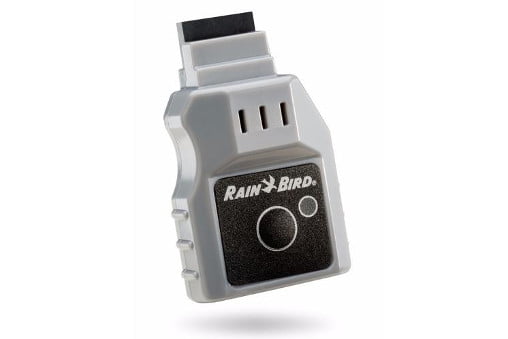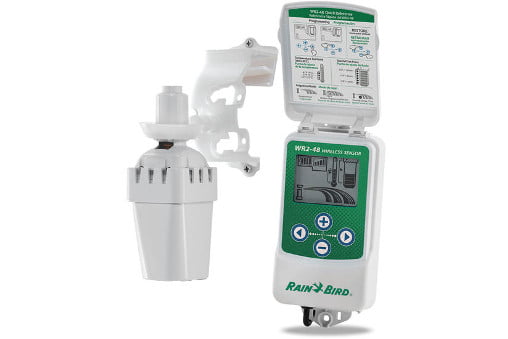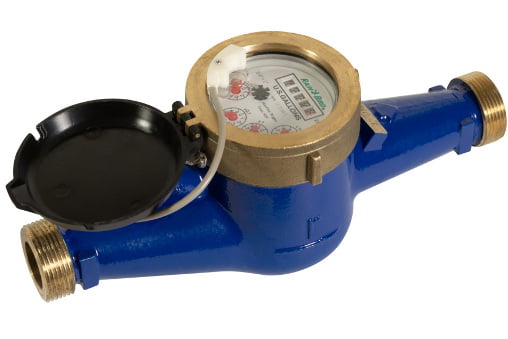Residential Irrigation Equipment
Commonwealth Irrigation and Landscape is a “Select Gold Standard Rain Bird Contractor”. We specialize in the installation of Rain Bird equipment. Although we are trained to use any manufacturers’ equipment, we feel that Rain Bird provides the best technology and quality on the market. We hope to answer questions by outlining the most commonly used equipment below.
Sprinkler Heads
The most commonly used sprinkler is either a spray head or a rotary head. The types of sprinkler heads we install are determined by the water pressure available, dimensions of the area being covered, and a variety of other factors.

Spray Heads
This is the most common item thought of when thinking of a sprinkler system. These spray heads are dispersed around the lawn in various positions and in planting beds.
The spacing between sprinklers can vary depending upon the specific nozzle installed in the head, but they are rarely spaced further than 15 feet apart.
The pop-up heights vary between manufacturers with 2″, 3″, 4″, 6″, and 12″ pop up sprays being the most commonly available. The high-pop-up models including the 6 inch and 12 inch are mostly used for flower and shrubbery bed areas.
The most basic version of a spray head is a fixed head mounted on a flex fitting with flex hose. The flex fitting with flex pipe allows for easy adjustments as plants and landscapes mature. Risers are sometimes used as well, with the spray head on top.

Rotary Heads
These sprinklers are larger devices that are used in open, un-interrupted spaces that allow water to be dispersed 25 to 30 feet or more. These heads typically pop-up during use and retract after operation for use in lawns or other areas with foot traffic. When in use the rotary head “rotates” based on its set radius to irrigate its assigned turf space.

Sprinkler Nozzles
The nozzle is a device that water passes through as it is leaving the head and is to be dispersed onto the landscape. Commonwealth Irrigation & Landscape relies on different nozzles to vary the quantity of water dispersed during the watering cycle, as well as the distance that water is to be thrown by each head. There are a variety of nozzles that can be used based on the irrigation needs. We utilize spray nozzles, rotary nozzles, and misting nozzles in an effort to match precipitation rates across the same zone.
Valves and Zones
Valves are the mechanical devices that turn the water on and off to the individual sections of the system. We break the area up into different “zones” or “stations” based on the layout. There are two basic types of valves being used today. Automatic valves which are operated by an electric controller, and manual valves that require a person to turn them on and off.

Manual Valves
Manual valves require you to have a wrench (or valve key) to turn them on. Systems with manual valves are seldom installed today. We can easily upgrade a system with manual valves to an automatic control system for greater efficiency.

Automatic Valves
Most systems installed today rely on automatic electric valves. These are the easiest systems to maintain and control. Most automatic valves operate on 24-volt electricity. Wires run in the ground along with the main line pipe to the valve and are connected to the controller. When the controller sends the 24-volt current to the valve, it opens. When the current is cut the valve closes.
Controllers, Sensors, and Smart Technology

Irrigation Timers, Controllers, and Clock
All three terms refer to the same piece of equipment, a device that controls the irrigation system and turns it on and off at a desirable time and operates the system for a preset period of time. The most common name referred to for this type of equipment is a controller. There are many different types of controllers on the market that offer a variety of features. Standard controllers are most common, but there are controllers that are internet-connected and those that are considered SMART controllers.

Wi-Fi Link
The LNK WiFi Module allows easy control of a Rain Bird irrigation system from anywhere.
Combined with Rain Bird’s FREE mobile app, get real-time alerts and advanced water management tools via your smartphone or tablet. With the seasonal adjust feature activated, weather data is gathered from the internet and is used to adjust system runs times on a daily basis. Combined with the WR2 Rain sensor, up to a 30% water savings can be achieved.

Rain Sensors
This item saves water and extends irrigation system life by automatically measuring precipitation and keeping irrigation systems from watering in rainy conditions. This is easily adjustable and an extension of your controller device.

Flow Sensors
We recommend the MJ100B series flow sensor for most applications. Built in Flo-Watch functionality in the ESP-ME3 controller uses information from the MJ100B to constantly monitor for low-flow and excess-flow conditions caused by broken lines or heads. When a problem is detected, it automatically shuts the area down (when combined with the WiFi Link), while continuing to irrigate non-affected areas. Protecting against overuse of water by leaks or damage and protecting pumps against low flow damage.
| Counties | |||
| Albemarle County, Virginia | Lancaster County, Virginia | ||
| Amelia County, Virginia | Loudoun County, Virginia | ||
| Arlington County, Virginia | Louisa County, Virginia | ||
| Buckingham County, Virginia | Madison County, Virginia | ||
| Caroline County, Virginia | Mathews County, Virginia | ||
| Charles City County, Virginia | Middlesex County, Virginia | ||
| Chesterfield County, Virginia | Nelson County, Virginia | ||
| Culpeper County, Virginia | New Kent County, Virginia | ||
| Cumberland County, Virginia | Northumberland County, Virginia | ||
| Essex County, Virginia | Orange County, Virginia | ||
| Fairfax County, Virginia | Powhatan County, Virginia | ||
| Fauquier County, Virginia | Prince George County, Virginia | ||
| Fluvanna County, Virginia | Prince William County, Virginia | ||
| Gloucester County, Virginia | Rappahannock County, Virginia | ||
| Goochland County, Virginia | Richmond County, Virginia | ||
| Greene County, Virginia | Shenandoah County, Virginia | ||
| Hanover County, Virginia | Spotsylvania County, Virginia | ||
| Henrico County, Virginia | Stafford County, Virginia | ||
| James City County, Virginia | Warren County, Virginia | ||
| King George County, Virginia | Westmoreland County, Virginia | ||
| King William County, Virginia | York County, Virginia | ||
| King and Queen County, Virginia | |||
| Cities |
| Alexandria, Virginia |
| Colonial Heights, Virginia |
| Falls Church, Virginia |
| Fredericksburg, Virginia |
| Hopewell, Virginia |
| Manassas, Virginia |
| Manassas Park, Virginia |
| Petersburg, Virginia |
| Poquoson, Virginia |
| Richmond, Virginia |
| Williamsburg, Virginia |
| Winchester, Virginia |

